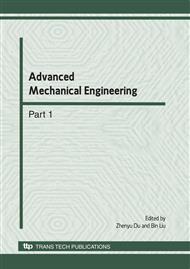p.498
p.502
p.507
p.512
p.517
p.523
p.528
p.535
p.539
Kinematics Analysis and Simulation of a Quadruped Robot
Abstract:
This paper presents the mechanical configuration of a quadruped robot with 4 rotary joints per leg firstly. All joints of the robot are activated by 16 identical hydraulic servo cylinders. Then it gives the forward and inverse kinematic equations of one leg with D-H transformation matrix. Furthermore, it also gives the jacobian matrix of the legs. The jacobian matrix establishes the relationships between the angle velocities of the 4 joints of the supporting leg and the moving velocity of the robot trunk. Lastly, a simple trot gait simulation is given based on MSC.ADAMS under the assumption that there are no slippages between the supporting feet and the ground.
Info:
Periodical:
Pages:
517-522
Citation:
Online since:
June 2010
Authors:
Keywords:
Price:
Сopyright:
© 2010 Trans Tech Publications Ltd. All Rights Reserved
Share:
Citation:


